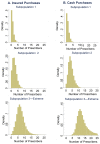Estimating the prevalence of opioid diversion by "doctor shoppers" in the United States
- PMID: 23874923
- PMCID: PMC3714248
- DOI: 10.1371/journal.pone.0069241
Estimating the prevalence of opioid diversion by "doctor shoppers" in the United States
Abstract
Background: Abuse of prescription opioid analgesics is a serious threat to public health, resulting in rising numbers of overdose deaths and admissions to emergency departments and treatment facilities. Absent adequate patient information systems, "doctor shopping" patients can obtain multiple opioid prescriptions for nonmedical use from different unknowing physicians. Our study estimates the prevalence of doctor shopping in the US and the amounts and types of opioids involved.
Methods and findings: The sample included records for 146.1 million opioid prescriptions dispensed during 2008 by 76% of US retail pharmacies. Prescriptions were linked to unique patients and weighted to estimate all prescriptions and patients in the nation. Finite mixture models were used to estimate different latent patient populations having different patterns of using prescribers. On average, patients in the extreme outlying population (0.7% of purchasers), presumed to be doctor shoppers, obtained 32 opioid prescriptions from 10 different prescribers. They bought 1.9% of all opioid prescriptions, constituting 4% of weighed amounts dispensed.
Conclusions: Our data did not provide information to make a clinical diagnosis of individuals. Very few of these patients can be classified with certainty as diverting drugs for nonmedical purposes. However, even patients with legitimate medical need for opioids who use large numbers of prescribers may signal dangerously uncoordinated care. To close the information gap that makes doctor shopping and uncoordinated care possible, states have created prescription drug monitoring programs to collect records of scheduled drugs dispensed, but the majority of physicians do not access this information. To facilitate use by busy practitioners, most monitoring programs should improve access and response time, scan prescription data to flag suspicious purchasing patterns and alert physicians and pharmacists. Physicians could also prevent doctor shopping by adopting procedures to screen new patients for their risk of abuse and to monitor patients' adherence to prescribed treatments.
Conflict of interest statement
Figures



References
-
- Substance Abuse and Mental Health Services Administration (2003) Emergency Department Trends from the Drug Abuse Warning Network, Final Estimates 1995–2002. Rockville, MD: Office of Applied Studies.
-
- Substance Abuse and Mental Health Services Administration (2011) Drug Abuse Warning Network, 2009: National Estimates of Drug-Related Emergency Department Visits. Rockville, MD: Substance Abuse and Mental Health Services Administration.
-
- Substance Abuse and Mental Health Services Administration (2009) Treatment Episode Data Set (TEDS) Highlights - 2007 National Admissions to Substance Abuse Treatment Services. Rockville, MD: Office of Applied Studies.
-
- Substance Abuse and Mental Health Services Administration (2013) The DAWN Report: Highlights of the 2011 Drug Abuse Warning Network (DAWN) Findings on Drug-Related Emergency Department Visits. Rockville, MD: Center for Behavioral Health Statistics and Quality. - PubMed
-
- Substance Abuse and Mental Health Services Administration (2012) Treatment Episode Data Set (TEDS): 2000–2010. National Admissions to Substance Abuse Treatment Services. S-61 ed. Rockville, MD: Center for Behavioral Health Statistics and Quality.
Publication types
MeSH terms
Grants and funding
LinkOut - more resources
Full Text Sources
Other Literature Sources
Medical
Miscellaneous

